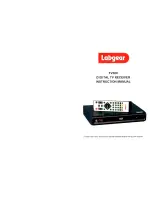
Page 10 of 24
4.3.a
To install the batteries:
1)
Carefully unhook the rear clasp by slightly raising it
and catching the depression with a fingernail, then
rotating the clasp downwards.
2) Carefully lift the rear protective cover from the
battery compartment and remove it.
3)
Insert the batteries (rechargeable or alkaline) in the
battery compartment, ensuring the batteries are
correctly oriented in their polarity, as indicated on the
inside of the battery compartment.
4)
Carefully insert the cover’s tabs into the slots at the
top of the battery compartment, and then slowly
press the cover down against the battery
compartment until it is perfectly aligned with the
transceiver body.
5)
Carefully return the clasp onto the protective cover, pressing until it clicks into place.
!
Ensure you have properly closed the battery compartment cover.
4.3.b
To remove the batteries:
1)
Follow steps 1 and 2 as outlined above.
2)
Remove the batteries from the radio.
3)
Follow steps 4 and 5 as outlined above.
4.4
Recharging the batteries
Two types of battery chargers are available. Each one is able to charge NiMH batteries without removing them from the
radio:
•
Standard MW904 wall battery charger – this is the least expensive. It supplies a slow charge, allowing for maximum battery
life. For further details, refer to par. 4.4.a.
•
RC445 intelligent table-top battery charger – for rapid charging and greater flexibility of use. It also monitors the charge, and
once batteries are charged, switches to trickle charging. For further details, refer to par. 4.4.b.
New batteries do not immediately allow for maximum duty, as they must be “run in” through at least 3 complete cycles of
charge/discharge.
!
Use the battery charger only if you have installed four rechargeable NiMH batteries. Never attempt to charge other types
of batteries (particularly alkaline) – doing so may cause explosions or personal harm.
!
Read the battery usage warnings outlined in par. 2.2.
4.4.a
Standard MW904 wall battery charger
1)
Ensure the radio is turned off (it must remain off for the entire period of charging).
2)
Carefully lift the rubber flap on the right side of the transceiver, slipping a fingernail into the
center left part, and rotating it towards the right, as indicated in the figure.
3)
Insert the plug at the end of the MW904 battery charger cable into the
MIC CHG
socket, then
connect the battery charger to an AC power source.
4)
Once the batteries are charged (see table below for charging times), disconnect the battery
charger from the AC power source, then disconnect the transceiver from the battery charger.
5)
Return the rubber flap to its place.
Code
Battery capacity
(mAh)
Time
(hours)
C696 1.200
8
C697 1.700
11.5
C734 2.300
15.5
TABLE OF APPROXIMATE TIMES FOR COMPLETE RECHARGE,
ACCORDING TO THE BATTERY TYPE USED.
!
Do not overcharge the batteries! When the batteries are completely charged, the charging process does not stop
automatically. Do not forget to disconnect the transceiver from the battery charger as soon as possible after charging is
complete, otherwise you may seriously damage the batteries and/or the transceiver.
!
For successive charging, longer duty, and battery life, refer to par. 4.5.
!
Do not forget to replace the rubber flap after charging.
1
2
Содержание Handheld VHF Marine Transceiver
Страница 1: ...Page 1 of 24 Ocean Handheld VHF Marine Transceiver USER S MANUAL ...
Страница 21: ...Page 21 of 24 ...










































